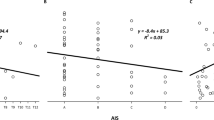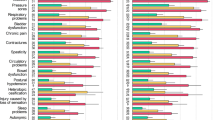Abstract
Study design
Observational study.
Objectives
To assess the construct validity of the International Standards to Document Remaining Autonomic Function after Spinal Cord Injury (ISAFSCI) (2012 1st Edition).
Setting
Two Canadian spinal cord injury (SCI) centers.
Methods
Data were collected between 2011–2014. Assessments included the ISAFSCI, standardized measures of autonomic function and a clinical examination. Construct validity of ISAFSCI was assessed by testing a priori hypotheses on expected ISAFSCI responses to standard measures (convergent hypotheses) and clinical variables (clinical hypotheses).
Results
Forty-nine participants with an average age of 45 ± 12 years were included, of which 42 (85.7%) were males, 37 (77.6%) had a neurological level of injury at or above T6, and 23 (46.9%) were assessed as having motor and sensory complete SCI. For the six General Autonomic Function component hypotheses, two hypotheses (1 clinical, 1 convergent) related to autonomic control of blood pressure and one clinical hypothesis for temperature regulation were statistically significant. In terms of the Lower Urinary Tract, Bowel and Sexual Function component of the ISAFSCI, all the hypotheses (5 convergent, 3 clinical) were statistically significant except for the hypotheses on female sexual items (2 convergent, 2 clinical), likely due to small sample size.
Conclusion
The construct validity of ISAFSCI (2012 1st Edition) for the General Autonomic Function component was considered to be weak while it was much stronger for the Lower Urinary Tract, Bowel and Sexual Function component based on a priori hypotheses. These results can inform future psychometric studies of the ISAFSCI (2021 2nd Edition).
This is a preview of subscription content, access via your institution
Access options
Subscribe to this journal
Receive 12 print issues and online access
$259.00 per year
only $21.58 per issue
Buy this article
- Purchase on Springer Link
- Instant access to full article PDF
Prices may be subject to local taxes which are calculated during checkout
Similar content being viewed by others
Data availability
The datasets analysed during the current study are available from the corresponding author on reasonable request.
References
Krassioukov A. Autonomic function following cervical spinal cord injury. Respir Physiol Neurobiol. 2009;169:157–64.
Krassioukov A, Claydon VE. The clinical problems in cardiovascular control following spinal cord injury: an overview. Prog Brain Res. 2006;152:223–9.
Savic G, Bergstrom EM, Frankel HL, Jamous MA, Jones PW. Inter-rater reliability of motor and sensory examinations performed according to American Spinal Injury Association standards. Spinal Cord. 2007;45:444–51.
Marino RJ, Graves DE. Metric properties of the ASIA motor score: subscales improve correlation with functional activities. Arch Phys Med Rehabil. 2004;85:1804–10.
Krassioukov AV, Karlsson AK, Wecht JM, Wuermser LA, Mathias CJ, Marino RJ. Assessment of autonomic dysfunction following spinal cord injury: rationale for additions to International Standards for Neurological Assessment. J Rehabil Res Dev. 2007;44:103–12.
Reitz A, Tobe V, Knapp PA, Schurch B. Impact of spinal cord injury on sexual health and quality of life. Int J Impot Res. 2004;16:167–74.
Alexander MS, Biering-Sorensen F, Bodner D, Brackett NL, Cardenas D, Charlifue S, et al. International Standards to Document Remaining Autonomic Function after Spinal Cord Injury. Spinal Cord. 2009;47:36–43.
Krassioukov A, Biering-Sorensen CF, Donovan W, Kennelly M, Kirshblum S, Krogh K, et al. International Standards to Document Remaining Autonomic Function after Spinal Cord Injury (ISAFSCI). First Edition 2012. Top Spinal Cord Inj Rehabil. 2012;18:283–96.
Wecht JM, Wilson J, Previnaire JG. Using the autonomic standards to assess orthostatic hypotension in persons with SCI: a case series. Spinal Cord Ser Cases. 2017;3:17087.
Previnaire JG, Soler JM, Alexander MS, Courtois F, Elliott S, McLain A. Prediction of sexual function following spinal cord injury: a case series. Spinal Cord Ser Cases. 2017;3:17096.
Beano HM, Kennelly M. Lower urinary tract autonomic dysfunction evaluation in spinal cord injury patients: an applied example. Spinal Cord Ser Cases. 2017;3:17098.
Alexander M, Carr C, Alexander J, Chen YY, McLain A. Assessing the ability of the Sacral Autonomic Standards to document bladder and bowel function based upon the ASIA Impairment Scale. Spinal Cord Ser Cases. 2019;5:85.
Montesinos-Magraner L, Castellano-Tejedor C, Frías A, Launois P, Rojas-Cuotto K, González-Viejo MA. Spanish validation of the Autonomic Standards Assessment Form in spinal cord injuries. Rehabilitacion (Madr). 2019;53:20–7.
Davidson RA, Carlson M, Fallah N, Noonan VK, Elliott SL, Joseph J, et al. Inter-rater reliability of the international standards to document remaining autonomic function after spinal cord injury. J Neurotrauma. 2017;34:552–8.
Wecht JM, Krassioukov A, Alexander M, Handrakis JP, McKenna SL, Kennelly M, et al. International Standards to Document Autonomic Function Following SCI (ISAFSCI): Second Edition. Top Spinal Cord Inj Rehabil. 2021;27:23–49.
American Spinal Injury Association. Autonomic Standards Assessment Worksheet (General and Sacral). https://asia-spinalinjury.org/wp-content/uploads/2022/02/ISAFSCI-Autonomic-General-and-Sacral-Exam-Worksheets.pdf. Accessed: March, 2022.
Kimberlin CL, Winterstein AG. Validity and reliability of measurement instruments used in research. Am J Health Syst Pharm. 2008;65:2276–84.
Fayers PM, Machin D. Quality of life: assessment, analysis and interpretation. 1st ed. Chichester: John Wiley and Sons. 2000; 43–71.
Suarez GA, Opfer-Gehrking TL, Offord KP, Atkinson EJ, O’Brien PC, Low PA. The Autonomic Symptom Profile: a new instrument to assess autonomic symptoms. Neurology. 1999;52:523–8.
Costa P, Perrouin-Verbe B, Colvez A, Didier J, Marquis P, Marrel A, et al. Quality of life in spinal cord injury patients with urinary difficulties, development and validation of Qualiveen. Eur Urol. 2001;39:107–13.
Krogh K, Christensen P, Sabroe S, Laurberg S. Neurogenic Bowel Dysfunction Score. Spinal Cord. 2006;44:625–31.
Rosen RC, Riley A, Wagner G, Osterloh IH, Kirkpatrick J, Mishra A. The International Index of Erectile Function (IIEF): a multidimensional scale for assessment of erectile dysfunction. Urology. 1997;49:822–30.
Rosen R, Brown C, Heiman J, Leiblum S, Meston C, Shabsigh R, et al. The Female Sexual Function Index (FSFI): a multidimensional self-report instrument for the assessment of female sexual function. J Sex Marital Ther. 2000;26:191–208.
Bonniaud V, Parratte B, Amarenco G, Jackowski D, Didier J-P, Guyatt G. Measuring quality of life in multiple sclerosis patients with urinary disorders using the Qualiveen questionnaire. Arch Phys Med Rehabil. 2004;85:1317–23.
Alexander MS, Brackett NL, Bodner D, Elliot S, Jackson A, Sonksen J, et al. Measurement of sexual functioning after spinal cord injury: preferred instruments. Spinal Cord Med. 2009;32:226–36.
McHorney CA, Ware JE Jr, Raczek AE. The MOS 36-item short-form health survey (SF-36): II. Psychometric and clinical tests of validity in measuring physical and mental health constructs. Med Care. 1993;31:247–63.
Claydon VE, Krassioukov A. Orthostatic hypotension and autonomic pathways after spinal cord injury. J Neurotrauma. 2006;23:1713–25.
West C, Bellantoni A, Krassioukov A. Cardiovascular function in individuals with incomplete spinal cord injury: a systematic review. Top Spinal Cord Inj Rehabil. 2013;19:267–78.
West W, Wong S, Krassioukov A. Autonomic cardiovascular control in Paralympic athletes with spinal cord injury. Med Sci Sports Exerc. 2014;46:60–8.
Ravensbergen HJ, de Groot S, Post MW, Slootman HJ, van der Woude LH, Claydon VE. Cardiovascular function after spinal cord injury: prevalence and progression of dysfunction during inpatient rehabilitation and 5 years following discharge. Neurorehabilit Neural Repair. 2014;28:219–29.
Welk L, Morrow S, Madarasz W, Baverstock R, Macnab J, Sequeira K. The validity and reliability of the Neurogenic Bladder Symptom Score. J Urol. 2014;192:452–7.
Wyndaele JJ. Neuroanatomy and neurophysiology of sexual function after spinal cord lesion. Spinal Cord. 2010;48:181.
Previnaire JG, Soler JM, Alexander MS, Courtois F, Elliott S, McLain A. Prediction of sexual function following spinal cord injury: a case series. Spinal Cord Ser Cases. 2017;3:1–7.
Acknowledgements
We would like to acknowledge all the study participants.
Funding
This work was supported by a grant from the Praxis Spinal Cord Institute which receives funding from Western Economic Diversification Canada and British Columbia government. The study was also supported by a grant from the BC Rehab Foundation.
Author information
Authors and Affiliations
Contributions
DK was responsible for statistical analysis, interpreting the results and writing the manuscript. RD and MC contributed to the study design, generated the hypotheses, collected data, interpreted the results and edited the manuscript. KS and JJ supervised data collection, interpreted the results and edited the manuscript. SE contributed to the study design, generated the hypotheses, interpreted the results and edited the manuscript. VN provided input on the analysis plan, hypotheses generation, interpreting the results and edited the manuscript. NF provided feedback on the analysis and edited the manuscript. AK supervised the project and study design, provided feedback on the generation of hypotheses and edited the manuscript.
Corresponding author
Ethics declarations
Competing interests
DK, NF and VN are employees of the Praxis Spinal Cord Institute. The other authors declare that there are no competing financial interests or conflict of interests in relation to the work described.
Ethical Approval and Consent to Participate
Research Ethics Board (REB) approval from the hospital and university was obtained for this work. We further certify that all applicable institutional and governmental regulations concerning the ethical use of human volunteers were followed during the course of this research and that informed consent was obtained from all participants.
Additional information
Publisher’s note Springer Nature remains neutral with regard to jurisdictional claims in published maps and institutional affiliations.
Supplementary information
41393_2023_932_MOESM1_ESM.pdf
The International Standards to Document Remaining Autonomic Function after Spinal Cord Injury (ISAFSCI) Assessment Forms (versions 1 and 2).
41393_2023_932_MOESM2_ESM.docx
Standard Questions for the International Standards to Document Remaining Autonomic Function after Spinal Cord Injury (ISAFSCI)
Rights and permissions
Springer Nature or its licensor (e.g. a society or other partner) holds exclusive rights to this article under a publishing agreement with the author(s) or other rightsholder(s); author self-archiving of the accepted manuscript version of this article is solely governed by the terms of such publishing agreement and applicable law.
About this article
Cite this article
Kurban, D., Davidson, R.A., Smith, K.M. et al. Construct validity of the international standards to document remaining autonomic function after spinal cord injury (ISAFSCI) (1st edition). Spinal Cord 61, 644–651 (2023). https://doi.org/10.1038/s41393-023-00932-z
Received:
Accepted:
Published:
Issue Date:
DOI: https://doi.org/10.1038/s41393-023-00932-z



